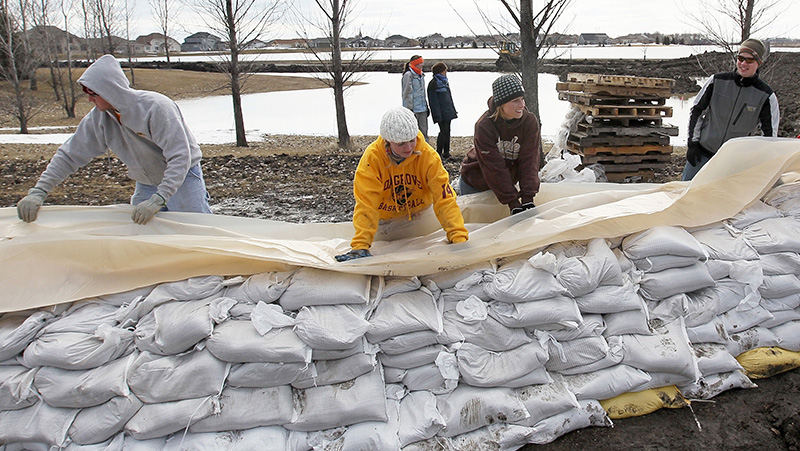
One of the biggest problems with the Federal Emergency Management Agency’s flood insurance program is that, nationwide, few property owners actually choose to buy into it.
But that’s not the case in many counties in the Federal Reserve’s Ninth District.
Sixty-five percent of the properties insured against flooding in the Minneapolis Fed’s region are located outside high-risk zones. That means those property owners bought policies not because they had to, but because they chose to. Only in high-risk zones is insurance usually a requirement for those with federally backed mortgages.
But voluntary insurance purchases outside those high-risk zones are 24 percentage points higher across the Ninth District than the U.S. average.
This and other key findings emerged from a deluge of data FEMA began releasing earlier this year about the National Flood Insurance Program, a program under financial pressure with rising damage from hurricanes and high water. (To learn more about flood insurance, see “Flood insurance: Rolling some expensive dice.”)
The data include 48.3 million records on NFIP policies sold since 2009 and 2.4 million records on NFIP claims made since 1970. Of these, 428,000 policy records and 32,000 claims records were in the Ninth District.
The data show that areas with high voluntary rates had a lot of experience with flooding. In the Red River watershed straddling the North Dakota and Minnesota border, 76 percent of all policy purchases over the past decade were voluntary (Chart 1). In North Dakota’s Souris River watershed, which suffered a flood disaster in 2011, the voluntary rate was 96 percent.
“We’ve known quite a while that our community is very—what we like to call—‘flood aware,’” said Nathan Boerboom, a city engineer overseeing flood control efforts in the Red River city of Fargo, N.D. “They understand that they have a risk. We’ve created a lot of tools available for them to see what their home risk is.”
The voluntary rate in Fargo is also 96 percent.
Residents have had many reminders about flood risks both from the river, which nearly forced the city to evacuate in 2009, and from city hall. One of the tools Boerboom mentioned is an online map that shows which buildings will be flooded at different river levels. Property owners can see that they don’t have to be in one of the high-risk zones to worry about flooding.
Higher risk awareness, high payouts
Experts have attributed the low rate of voluntary purchases nationally to a lack of awareness of flood risks.
That seems to be less of a problem in the Red River and Souris River watersheds.
Over the five-decade history of NFIP, the program has paid claims totaling $352.5 million (adjusted for inflation) in counties in the Red River watershed (Chart 2). That’s 57 percent of all claims paid in the entire Ninth District. The next highest are the Souris River watershed with $97.3 million and the Little Missouri River watershed, primarily in Montana and North Dakota, with $81.7 million.
The vast majority of those payments emerged from singular events: the 1997 flood for the Red River and 2011 floods for the other two watersheds.
The pattern of disproportionate impact to NFIP by a relatively small number of flood disasters in relatively small areas can be seen nationwide. For example, of the $90.5 billion in claims NFIP has paid over its 50-year history, a fifth went to Louisiana counties in 2005, the year Hurricane Katrina devastated New Orleans.
While Fargo itself has escaped major catastrophe, residents have watched others lose their homes to flooding. The downstream cities of Grand Forks, N.D., and East Grand Forks, Minn., were almost completely engulfed by the Red River in 1997. Fargo’s narrowest escape came in 2009, when floodwaters nearly overtopped emergency clay levees. Since that flood, residents have mobilized to stack sandbags in four of the past 10 years.
As the city worked with the U.S. Army Corps of Engineers to upgrade its flood protection, they recalculated the flood risk and realized how outdated FEMA’s flood plain map had become.
According to the map, which is used to set insurance rates, the elevation of a 100-year flood is 39.3 feet. The city and corps found that it was actually 41 feet, according to Boerboom.
Those 20 inches make a big difference in a city built on what was once the flat bottom of an Ice Age lake. The 100-year flood on FEMA’s map would flood 1,800 buildings, mostly in the southern third of Fargo. The actual 100-year flood as determined by the city and corps would flood 11,000 buildings, roughly a third of all buildings in the city.
A 100-year flood is the threshold where risks are high enough to warrant FEMA mandating flood insurance. It’s a shorthand way of saying a flood with a 1 percent chance of occurring each year; over the 30-year life of a typical mortgage, the risk of such a flood is 26 percent. According to FEMA, the risk of a fire in the same period is 1 percent to 2 percent.
Minot, the biggest city in the Souris River watershed, also discovered that its flood map was outdated, but it found out the hard way. A majority of homes flooded in 2011 weren’t in the 100-year flood plain, and many didn’t have flood insurance. The current map, which dates to 2000, shows most of the area flooded in 2011 is in the low-to-moderate risk zone.
Low participation over all
But even in areas with high awareness of flood risks, insurance purchases voluntary or otherwise aren’t consistently high.
The penetration rate, which is the number of policies as a percentage of all buildings in an area, is roughly 10 percent in Fargo currently. The vast majority of those policies are for properties outside the 100-year flood plain. According to FEMA, the estimated penetration rate nationwide is 4 percent.
The number of policies has fluctuated through the years. Many property owners buy insurance during major flood years only to cancel their policies when they haven’t seen floods in a while.
For example, 10,005 policies were in force in Red River watershed counties in 2009, which was the middle of a particularly wet spell for the region. As of the end of March 2019, only 7,054 policies were in force.
Boerboom said that while many Fargo property owners do renew their policies every year, some game the program, which begins coverage within 30 days of purchase.
“Quite a few will also pay attention to what type of fall we had going into winter, how much snow we get early in the winter,” he said. “If it looks like there’s potential that we’re going to be experiencing a flood, they’ll buy flood insurance in [the] January or February time frame.”
It’s hard to blame people, he said. Fargo’s spring flood threat is often pretty easy to see far in advance, unlike flooding in other places more susceptible to flash floods, such as in Colorado, he said.
Big changes ahead
Changes are afoot for NFIP as FEMA tries to improve the way it measures flood risk for insurance purposes.
Currently, the 100-year flood plain is the main way of measuring risk. (To see if your property is in the flood plain use FEMA’s online map.) Those in the flood plain are considered at high risk and pay a much higher premium. Those outside are considered at low to moderate risk and pay a much lower premium. In the Ninth District, the average high-risk premium over the past decade was $1,114 per year, and the average low-to-moderate premium was $483.
Experts say this abrupt boundary can give rise to the belief that a property is safe if it’s not in the 100-year flood plain. Nature respects no such boundary. Nationwide, 20 percent of NFIP claims filed are from properties outside high-risk zones. But in the Ninth District, that figure averaged more than twice as much, or 56 percent, over the past decade.
Under an effort called Risk Rating 2.0, FEMA promises to measure risk in a broader spectrum. For example, it would add other measures of risk such as distance from the source of floodwaters, be it the coast or a river, and the kind of flooding, such as river flooding or overland flooding caused by heavy rain.
Boerboom said he hasn’t heard much about Risk Rating 2.0 from FEMA but, whatever happens, he hopes premiums will not increase too much for those outside the 100-year flood plain. Homeowners are willing to pay $300 to $600 per year, but that could change if the premium were several thousand dollars, he said, adding, “If they’re not mandated to buy flood insurance, they’re no longer buying flood insurance.”
Tu-Uyen Tran is the senior writer in the Minneapolis Fed’s Public Affairs department. He specializes in deeply reported, data-driven articles. Before joining the Bank in 2018, Tu-Uyen was an editor and reporter in Fargo, Grand Forks, and Seattle.





